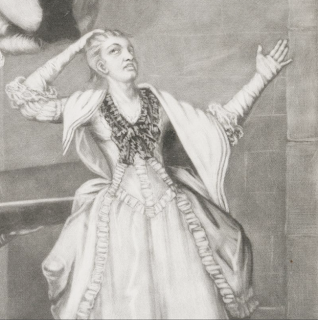Continuing with our theme of accessories, we have aprons! These could be worn for fashion or utility. Wearing white is often associated with lack of work, simply because it's hard to keep clean when doing labor. Most fashionable aprons appear to be a sheer white, although earlier in the century colored silk was popular (very short and covered in embroidery). Maids often have plain white, and even some country women are shown in that as well. Whether that is representative of what they wore, their Sunday best, or the artist made a conscious decision is hard to know (white could have translated as "clean", and some outfits of country maids are unusually fashionable). Colored and printed aprons were very much a working class object, hiding stains. If made from wool they are fire-proof and can serve many purposes when cooking (the pot holder is never out of reach!).
 The Cork Rump,
The Cork Rump, 1776 from the
Lewis Walpole Gallery, shows an extremely fashionable young lady, obviously satirizing the size of her bum roll. Her apron is relatively simple, made from a white fabric. It is short compared to many of the aprons you'll see further down the page. It also has two pockets with tassels, although I doubt they would ever hold much!
 Grown Ladies & c. taught to Dance
Grown Ladies & c. taught to Dance, 1769 from
CWF, shows another fashionably short apron. This time, it has a long ruffle along the bottom hem. From the picture it appears the ruffle begins where the apron hem ends, rather than the apron continuing underneath as trimmed petticoats do. You also see two sets of strings around the waist, although I can't discern a bow.
 The Wife at Confession to the Husband in Disguise
The Wife at Confession to the Husband in Disguise, 1780 from the
LWG. She has on a slightly longer and very sheer apron. A small ruffle continues all the way around. The shape is curved rather than rectangular.
 The Studious Beauty
The Studious Beauty, 1778 from
LWG. At first glance this fashionable woman's apron looks quite plain, but up close small stripes are visible. There is a slight color variation with the stripes, but that was probably the artists way of making them appear sheer rather than a grey line to denote them. She seems to be wearing it over her gown, since the apron continues on top of the gown skirt on the side.
 Rural Life
Rural Life, 1783 from
LWG. This young woman hardly looks "rural" by our standards. If only we could know just
how idealistic v. realistic this sort of thing was. I doubt she would be feeding chickens in such an outfit. Her apron is semi-sheer with an attached trim with scalloped edges, most likely embroidered to finish.
 Girl Buying a Ballad
Girl Buying a Ballad, 1778 from the
Tate. This is one of my favorite portraits, to be honest. She has on a very plain white apron. It's fairly long in length, ending only a couple inches above her gown hem, obscuring any view of the petticoat. It's tied at a very severe angle and the bow is visible in front. I've tried to accomplish this droop in the front, but with the bow on the outside the apron pulls down and the bow ends up high. Perhaps if I made one with the length uneven, as hers is, it might encourage it.
 Johnny Going to the Fair
Johnny Going to the Fair, 1790? from the
V&A. Wearing a plain outfit of jacket and petticoat, her apron ends about three inches up from the hem. Unadorned, but clean. You can also see the bow tied in front.
 A Ladies Maid Purchasing a Leek
A Ladies Maid Purchasing a Leek, 1772 from
LWG. Plain white, again about three inches above the petticoat hem (which seems rather short). It's put underneath the gown, with the bodice shape visible upon it.
 At the Inn Door
At the Inn Door, 1790 from the
V&A. A lovely solid green apron with the tie very visible in front. It's hard to tell the length since she's holding it to the side, but it appears to be in the same range of just a few inches shorter than the petticoat.
 The merry Milk Maid
The merry Milk Maid, 1733 from
LWG. A bit earlier than I usually go, but it shows a very simple apron being tied up out of the way. She's either tied the corners together in back or tucked them into her strings. Possibly to carry items or just to keep it clean. You can also see the bow tied in front.
 Plucking the Turkey
Plucking the Turkey, 1776 from the
Tate. A perfect example of a check'd apron. From the way it falls, it's of sturdy quality, either wool or heavy linen. While the bow is not visible, a second string pulling down below the waist of the apron is visible.
 The Tythe Pig
The Tythe Pig, 1742 from
LWG. Not only can we see how her apron has been pulled up on the side, but also how she pins up her gown (a good while before polonaising begins).
 The Sailors Return
The Sailors Return, 1786 from the
NMM. It appears to be a green check'd fabric. The hem also shows as very short compared to her petticoat. What I assume is her gown is draped over the chair back, meaning she wears the apron under it.
Most of the extant examples I came across were very fancy. Most aprons likely endured heavy use or cleaning, others were sheer and fragile. Embroidered silk from the earlier part of the century is not difficult to find. The V&A has numerous embroidery patterns suitable for aprons. However, Colonial Williamsburg seemed to have the best selection of styles:
Plain white, semi-sheer
White linen with colored embroidery
White cotton with woven pattern, drawstring top
Blue & White check'd linen




















































